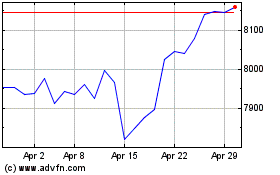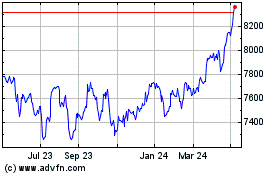By Mark DeCambre and Chris Matthews, MarketWatch
All three major benchmarks will start the day in correction
Stock benchmarks looked set to slump Monday after the Dow Jones
Industrial Average fell into correction territory last week, and
the three main benchmarks marked their worst start to December
trading since 1980, amid fears of global growth and an aggressive
Federal Reserve.
How did benchmarks trade?
Futures for the Dow were off 139 points, or 0.6%, at 23,974,
those for the S&P 500 were off 12.25 points, or 0.5%, at 2,590,
and Nasdaq-100 futures retreated 30.25 points to 6,569, a drop of
0.5%.
On Friday, the Dow fell 496.87 points, or 2%, to end at
24,100.51, for its lowest close since May 3. The S&P 500 shed
50.59 points, or 1.9%, to close at 2,599.95, its lowest finish
since April 2. The Nasdaq Composite Index dropped 58.59 points, or
0.8%, to finish at 6,910.66, marking its lowest close since Nov.
20.
The drop has left the Dow more than 10% below its Oct. 3 record
high, meeting the widely used definition of a correction. The
blue-chip gauge joined the S&P 500 and the Nasdaq in correction
phase.
Read: Here's why the Fed won't save the stock market, despite
its worst December start since 1980
(http://www.marketwatch.com/story/heres-why-the-fed-wont-save-the-stock-market-despite-its-worst-december-start-since-1980-2018-12-15)
What's driving the market?
Wall Street stocks are on track to slip to start the week as the
Fed will conclude its final policy meeting of 2018 on Wednesday.
Although the market is widely expecting a rate increase of a
quarter of a percentage point, investors will parse the bank's
statements and projections to understand policy makers' plans in
2019.
The central bank last issued projections for the future path of
interest rates in September, when it showed that the median member
of the Fed's interest-rate setting committee predicted the bank
would raise interest rates once more in December and three times in
2019.
Since that time, evidence of slowing global growth, a rising
dollar, and slower inflation has helped encourage Fed officials to
become more dovish in their public statements, while fed funds
futures markets show investors predict only one
(https://www.cmegroup.com/trading/interest-rates/countdown-to-fomc.html)
or fewer rate increases next year.
Anxieties over rate-setting come amid mounting signs of slowing
global growth, which investors worry could help to derail the bull
market.
On Friday, evidence of the effects of rising U.S.-China trade
tensions, and of a broader slowing of the Chinese economy, cropped
up as China released data
(http://www.marketwatch.com/story/china-economic-activity-mostly-slowed-in-november-2018-12-14)
that showed both industrial output and retail sales for November
missed economists' forecasts.
What are analysts saying?
"U.S. futures are showing zero rebound from Friday's weakness,
with tepid action ahead of a bevy of catalysts this week," wrote
Dave Lutz, head of ETFs at JonesTrading, in a note to clients,
arguing that traders are hesitant to make any big bets ahead of
events like a speech on economic policy from Chinese president Xi
Jinping due Tuesday, as well as the Fed decision.
"In summary; we look for a mixed sessions as investors weariness
continues to impact market sentiment.," wrote Peter Cardillo, chief
market economist at Spartan Capital Securities.
What data are ahead?
A reading of regional industrial production, the Empire State
index for December, showed manufacturing activity growing at a
sharply slower pace compared with November
(http://www.marketwatch.com/story/empire-state-factory-index-slumps-in-december-2018-12-17).
The index fell 12.4 points to 10.9 in December, below consensus
expectations of 21, according to a survey by Econoday.
A reading of home builders index for the same month is scheduled
for 10 a.m.
What stocks are in focus?
Shares of Best Buy Co Inc. (BBY) are in focus after Bank of
America downgraded the stock to underperform. The stock is down
5.5% in premarket action.
Johnson & Johnson(JNJ) shares remain under pressure before
the bell Monday, with the stock slipping 0.6%, after a more than
10% decline Friday following allegations
(http://www.marketwatch.com/story/johnson-johnson-stock-slammed-by-report-it-knew-of-asbestos-in-baby-powder-2018-12-14)
that it knew that its popular baby powder product was contaminated
with asbestos.
Jack in the Box Inc. (JACK) stock is surging 4.8% in premarket
trade, after the firm disclosed that it is exploring a possible
sale.
Goldman Sachs Group Inc. (GS) shares are down 1.9% in premarket
trade, after the Malaysian government filed criminal charges
against the bank and one of its former partners, in connection with
the 1MDB financial scandal.
How are other markets trading?
Asian stocks closed mixed Monday
(http://www.marketwatch.com/story/asian-shares-inch-higher-ahead-of-meetings-by-fed-chinas-economic-policymakers-2018-12-16),
with the Nikkei rising 0.6%, Hong Kong's Hang Seng virtually
unchanged, and the Shanghai Composite Index edging 0.1% higher.
In Europe, stocks are broadly lower, with the Stoxx Europe and
FTSE 100 retreating on Monday.
Crude oil
(http://www.marketwatch.com/story/oil-bounces-back-from-weekly-decline-2018-12-17)is
rising 0.4%
(http://www.marketwatch.com/story/oil-bounces-back-from-weekly-decline-2018-12-17),
while gold is advancing nearly 0.2% and the U.S. dollar retreating
0.3%.
(END) Dow Jones Newswires
December 17, 2018 09:16 ET (14:16 GMT)
Copyright (c) 2018 Dow Jones & Company, Inc.
FTSE 100
Index Chart
From Mar 2024 to Apr 2024

FTSE 100
Index Chart
From Apr 2023 to Apr 2024
